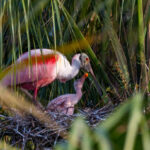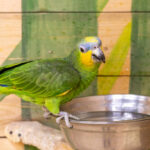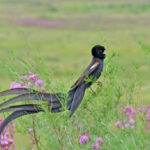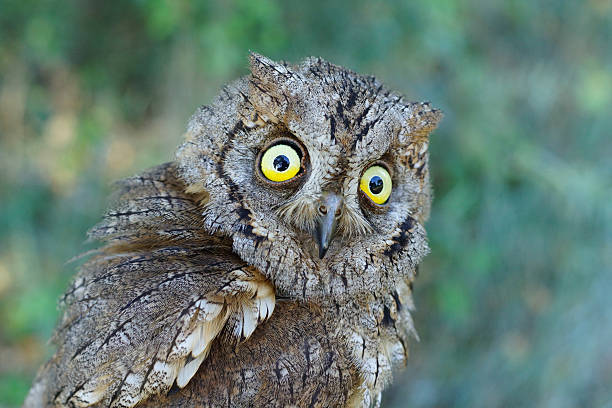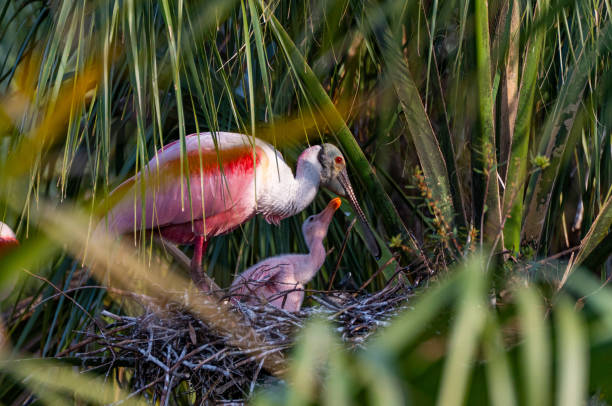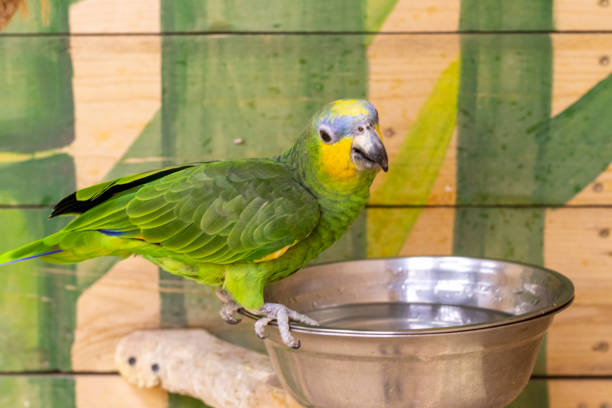Towering in the canopy of the Philippines’ lush rainforests reigns a magnificent apex predator: the Philippine Eagle (Pithecophaga jefferyi). This giant bird is amazing! It has impressive size and piercing blue eyes, making it the only blue-eyed bird of prey in the world. Its wingspan can stretch over two meters (6.5 feet). This critically endangered species is a true marvel of nature. Once called the “Monkey-Eating Eagle,” the Philippine Eagle got its name from its diet. It has the strength and skill to grab monkeys from the trees. Get ready to see the amazing techniques this majestic raptor uses to catch its prey in the thick jungle.
The Apex Predator of the Philippine Eagle : A Bird of Immense Power
The Philippine Eagle is not just a large bird; it’s a symbol of power and wildness. Standing at around a meter (3 feet) tall, it commands attention with its striking features:
- Immense Size and Build: As one of the largest eagles in the world in terms of length and wing surface area, the Philippine Eagle boasts a powerful build, equipped with strong legs and massive talons capable of exerting tremendous crushing force.
- Sharp Talons and Beak: Its razor-sharp talons can grow up to the size of an adult human finger, perfectly designed for grasping and dispatching prey. The large, high-arched beak is equally formidable, used for tearing flesh.
- Exceptional Vision: With eyesight estimated to be eight times sharper than that of humans, the Philippine Eagle can spot potential prey from incredible distances within the dense forest. Its unique blue eyes provide exceptional clarity.
- Agile Flight in Dense Forests: Despite its size, the Philippine Eagle possesses a relatively short but broad wingspan, an adaptation that allows for maneuverability and near-vertical take-offs within the dense and cluttered rainforest canopy.
- Distinctive Crest: Adding to its majestic appearance is a prominent, shaggy crest of brown and cream-colored feathers on its head and nape, giving it a regal and alert look.
Mastering the Hunt: The Philippine Eagle Tactical Brilliance
To thrive in the tough tropical rainforest, the Philippine Eagle uses smart hunting strategies:
- Still-Hunting: Patiently Waiting for the Unwary: One of the primary techniques employed by the Philippine Eagle is still-hunting. The eagle sits still on a high branch, quietly watching the forest floor and the trees. Its exceptional eyesight allows it to detect even the slightest rustle or movement that might betray the presence of prey. This “sit and wait” approach conserves energy and allows for a surprise attack.
- Perch-Hunting: Gliding Through the Canopy in Pursuit: The Philippine Eagle also engages in perch-hunting, a more active strategy. This involves periodically gliding from one perch to another through the forest canopy. While gliding, the eagle scans the vegetation below for potential prey. This method allows them to cover more ground and explore different levels of the forest in search of a meal. They often work their way gradually down from the canopy, and if unsuccessful, they will fly or circle back up to try again.
- Probing Dense Tangles: These skilled hunters have also been observed probing dense tangles of vines and knotholes in trees, using their powerful beak and talons to investigate potential hiding places for smaller prey.
- Cooperative Hunting (Occasionally): In some instances, particularly when targeting troops of monkeys, pairs of Philippine Eagles have been known to hunt cooperatively. One eagle will perch conspicuously nearby, acting as a distraction to draw the attention of the primates. The other eagle will quietly move into place. It gets ready to surprise the distracted monkeys from behind.
- The Swift Swoop: Once prey is spotted and within striking distance, the Philippine Eagle launches a swift and powerful dive or swoop. Its large size and sharp talons ensure a quick and decisive capture. They are surprisingly agile in the air, allowing them to navigate the complex three-dimensional environment of the rainforest canopy effectively.
More Than Just Monkeys: The Varied Diet of a Top Predator Eagle
The Philippine Eagle’s old name hints at a single focus, but it is actually an opportunistic hunter. Its diet is diverse and changes based on what prey is available and easy to catch. Monkeys, especially macaques, eat a lot of different foods. In some places, they rely on other animals too, like:
- Other Mammals: This includes flying lemurs (colugos), various species of civets (like the Asian palm civet), flying squirrels, tree squirrels, and giant cloud rats. They have even been reported to take young pigs and small dogs near human settlements.
- Birds: The Philippine Eagle also preys on other birds, including other birds of prey such as owls and hornbills.
- Reptiles: Large snakes and lizards, such as monitor lizards, are also part of their diet.
- Bats: Smaller prey like fruit bats and other bat species are also taken.
The Philippine Eagle has a varied diet, showing its importance as an apex predator. This helps control the populations of different vertebrates in its forest home.
Reigning Over the Canopy: Habitat and Distribution
The majestic Philippine Eagle is endemic to the Philippines, meaning it is found nowhere else in the world. Its distribution is limited to four main islands within the Philippine archipelago:
- Mindanao: This island harbors the largest remaining population of Philippine Eagles.
- Luzon: A smaller population exists in the eastern mountain ranges of Luzon.
- Samar: Only a few breeding pairs are known to survive on Samar.
- Leyte: The population on Leyte is also very small, with only a couple of known breeding pairs.
These magnificent eagles inhabit the canopies of primary dipterocarp forests, which are characterized by tall, resinous timber trees. They prefer steep and rugged mountainous areas with dense forest cover, typically ranging from lowland to montane forests up to elevations of around 1,450 meters (4,760 feet). These old-growth forests provide the necessary tall trees for nesting and a rich diversity of prey.
A Solitary Sovereign: Behavior and Life Cycle
Philippine Eagles are generally solitary birds, spending most of their time alone or in mated pairs. They are diurnal, meaning they are active during the day, hunting and tending to their territories. At night, they roost on tall, sturdy branches within their territory.
Once a pair forms, Philippine Eagles are believed to be monogamous, staying together for the rest of their lives. They establish large territories, sometimes exceeding 100 square kilometers (39 square miles), which they fiercely defend.
Breeding typically occurs once every two years. The female lays only one egg in a large stick nest high in a towering tree. Both parents participate in incubation and the long period of chick-rearing. The young eagle takes years to mature. This slow growth affects their reproduction and makes them more vulnerable.
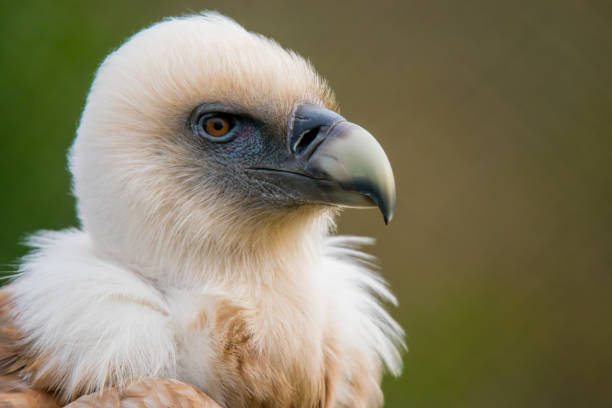
A National Treasure in Peril: Conservation Status
Tragically, the Philippine Eagle is one of the rarest and most critically endangered eagles in the world. The International Union for Conservation of Nature (IUCN) lists the species as Critically Endangered, with an estimated population of fewer than 400 breeding pairs remaining in the wild. The primary threats to their survival are:
- Habitat Loss and Degradation: Deforestation due to logging, mining, and agricultural expansion has destroyed vast areas of their old-growth forest habitat.
- Hunting and Trapping: Despite laws protecting the species, Philippine Eagles are still sometimes hunted or accidentally caught in traps set for other animals.
- Human Disturbance: Human activities near nesting sites can lead to nest abandonment and reduced breeding success.
- Pollution: Pesticides and other environmental contaminants can accumulate in their food chain, affecting their health and reproductive capabilities.
To save the Philippine Eagle from extinction, we need urgent action. This includes protecting its habitat and planting more trees. We must also enforce laws against hunting and educate communities. Raising awareness about this amazing national bird is key.
Conclusion: Witnessing a Master Hunter
The Philippine Eagle, a majestic ruler of the Philippine rainforest canopy, is a testament to the power and beauty of nature. Its ability to snatch a monkey mid-air is a dramatic illustration of its strength, agility, and hunting prowess. However, this incredible predator faces a precarious future. Knowing how it hunts and the dangers it faces is key. This helps us protect this national treasure. We want future generations to see this amazing “monkey-eating” eagle flying in the Philippine skies.
FAQs About the Philippine Eagle’s Hunting Habits
Q1: Is the Philippine Eagle the largest eagle in the world?
A: The Philippine Eagle is one of the largest eagles in the world in terms of length and wing surface area. Other eagles, like the Steller’s Sea Eagle and Harpy Eagle, may be heavier or have a larger wingspan, but the Philippine Eagle is consistently ranked among the top in size.
Q2: How does the Philippine Eagle manage to hunt monkeys in dense forests?
A: They employ a combination of still-hunting (patiently waiting on a perch) and perch-hunting (gliding through the canopy). Their exceptional eyesight allows them to spot monkeys from afar, and their agility and powerful talons enable them to snatch them swiftly from the trees. Cooperative hunting between pairs has also been observed.
Q3: Did the Philippine Eagle used to eat only monkeys?
A: No. Originally called the “Monkey-Eating Eagle,” this bird now has a varied diet. It eats different mammals, birds, reptiles, and bats, depending on what’s available.
Q4: How sharp is the Philippine Eagle’s vision?
A: Their vision is estimated to be eight times sharper than that of humans, allowing them to spot prey from great distances within the dense rainforest.
Q5: What are the biggest threats to the Philippine Eagle population?
A: The primary threats are habitat loss and degradation due to deforestation, as well as hunting and trapping. Human disturbance and pollution also contribute to their decline.
Q6: Where in the Philippines can you find the Philippine Eagle?
A: They are found on four main islands: Mindanao (with the largest population), Luzon, Samar, and Leyte, inhabiting the canopies of primary tropical rainforests.
Q7: How often do Philippine Eagles breed? A: They typically breed once every two years and lay only one egg per nesting attempt.
Q8: Are Philippine Eagles protected by law?
A: Yes, the Philippine Eagle is the national bird of the Philippines, and killing one is punishable by up to 12 years in prison and heavy fines. However, enforcement remains a challenge.
Q9: What role does the Philippine Eagle play in its ecosystem?
A: As an apex predator, the Philippine Eagle plays a crucial role in regulating the populations of various vertebrates within its rainforest ecosystem, helping to maintain a healthy balance.
Q10: What can be done to help conserve the Philippine Eagle?
Conservation efforts focus on several key areas:
- Protecting and restoring forest habitats.
- Strengthening laws against hunting and trapping.
- Promoting sustainable land use.
- Raising public awareness about this magnificent, critically endangered species.
